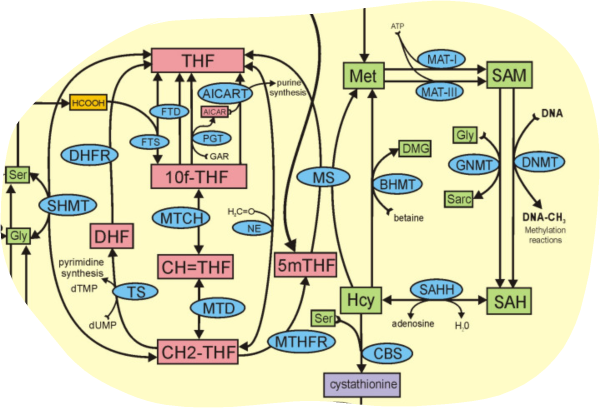One-carbon metabolism
From Proteopedia
One-carbon metabolism refers to biochemical pathways that transfer a single carbon. Typically, these reactions are catalyzed by enzymes using cofactors or prosthetic groups such as S-adenosyl methionine, tetrahydrofolate, flavine-adenine dinucleotide (FAD) or cobalamin, many of which are vitamin-derived[1][2]. The transfered carbon may have various oxidation states and end up as different functional groups such as methyl, methenyl, formyl, or carboxylate. One-carbon transfer reactions play a role in amino acid and nucleid acid biosynthesis, in epigenetics and cellular redox status [3].
Contents |
Overview
The picture below shows an overview of the metabolites (squares) and enzymes (ovals) of the one-carbon metabolism. You can hover over and click on selected metabolites and enzymes to learn more about individual parts of the pathway.
Folate cycle
The folate cycle connects the metabolites dihydrofolate (DHF) and tetrahydrofolate (THF) with four distinct methylated forms of tetrahydrofolate. The methylated forms are, in order of increasing oxidation state of the one-carbon unit, 5-methyl THF, 5,10-methylene THF, 5,10-methenyl THF and formyl THF. While most transformation in the pathway are possible in either direction, the reaction from 5,10-methenyl THF to DHF (transferring a methyl group to dUMP) and from DHF to THF (a reduction by NADPH) proceed in one direction only. Methionine synthase connects the folate and the methionine cycle by transfering a methyl group from 5-methyl THF to homocysteine.
Methionine cycle
As a cofactor of hundreds of enzymes, S-adenosyl methionine is the most common methyl group donating cofactor. After donating the methyl group, the remaining S-adenosyl homocysteine is hydrolyzed to adenosine and homocysteine. Homocysteine is methylated (mostly by methioine synthase, which connects the folate cycle and the methionine cycle) to form methionine, which then reacts with ATP to form S-adenosyl methione (and triphosphate). Different from the folate cycle, these reactions are unidirectional, and each cycle costs the equivalent of three ATP to ADP reactions.
Sources and destinations of carbon
Sources of carbon include the conversion of serine to glycine (by Serine hydroxymethyltransferase), formic acid (HCOOH [4], breakdown of glycine (glycine cleavage system), and methyl groups obtained from demethylation reactions.
The one-carbon units are used in synthesis of nucleic acids, amino acids, lipids and various other metabolites. The folate cycle provides methyl groups directly for synthesizing dTMP from dUMP, for purine synthesis, and for formylating methionine. By providing methyl groups to the methioine cycle, it indirectly provides methyl groups for methylation of DNA, neurotransmitters, various lipids and many other metabolites.
In the animation below, two scenarios are shown. In both, the carbon enters the cycle by removing a one-carbon unit from serine. In one scenario, the carbon is used to methylate dUMP to yield dTMP for DNA synthesis, in the other it is used to methylate DNA as part of epigenetic modification.
Links to pages on specific enzymes in the pathway
- Dihydrofolate reductase
- Methionine adenosyltransferase
- Thymidylate synthase
- Methionine synthase
- Methylenetetrahydrofolate reductase
- Folylpolyglutamate synthase
- Serine hydroxymethyltransferase
- S-adenosylhomocysteine hydrolase
Further reading
- Origin of methyl groups in the pathway[5]
- Cell cycle regulation [6]
- Epigenetics [7]
- Vision changes after spaceflight[8]
References
- ↑ Li K, Wahlqvist ML, Li D. Nutrition, One-Carbon Metabolism and Neural Tube Defects: A Review. Nutrients. 2016 Nov 23;8(11). pii: nu8110741. doi: 10.3390/nu8110741. PMID:27886045 doi:http://dx.doi.org/10.3390/nu8110741
- ↑ Zheng Y, Cantley LC. Toward a better understanding of folate metabolism in health and disease. J Exp Med. 2019 Feb 4;216(2):253-266. doi: 10.1084/jem.20181965. Epub 2018 Dec, 26. PMID:30587505 doi:http://dx.doi.org/10.1084/jem.20181965
- ↑ Ducker GS, Rabinowitz JD. One-Carbon Metabolism in Health and Disease. Cell Metab. 2017 Jan 10;25(1):27-42. doi: 10.1016/j.cmet.2016.08.009. Epub 2016, Sep 15. PMID:27641100 doi:http://dx.doi.org/10.1016/j.cmet.2016.08.009
- ↑ Pietzke M, Meiser J, Vazquez A. Formate metabolism in health and disease. Mol Metab. 2020 Mar;33:23-37. doi: 10.1016/j.molmet.2019.05.012. Epub 2019 Jul, 30. PMID:31402327 doi:http://dx.doi.org/10.1016/j.molmet.2019.05.012
- ↑ Locasale JW. Serine, glycine and one-carbon units: cancer metabolism in full circle. Nat Rev Cancer. 2013 Aug;13(8):572-83. doi: 10.1038/nrc3557. Epub 2013 Jul 4. PMID:23822983 doi:http://dx.doi.org/10.1038/nrc3557
- ↑ Lan X, Field MS, Stover PJ. Cell cycle regulation of folate-mediated one-carbon metabolism. Wiley Interdiscip Rev Syst Biol Med. 2018 Nov;10(6):e1426. doi:, 10.1002/wsbm.1426. Epub 2018 Jun 11. PMID:29889360 doi:http://dx.doi.org/10.1002/wsbm.1426
- ↑ Friso S, Udali S, De Santis D, Choi SW. One-carbon metabolism and epigenetics. Mol Aspects Med. 2017 Apr;54:28-36. doi: 10.1016/j.mam.2016.11.007. Epub 2016 Nov, 19. PMID:27876555 doi:http://dx.doi.org/10.1016/j.mam.2016.11.007
- ↑ Zwart SR, Gibson CR, Mader TH, Ericson K, Ploutz-Snyder R, Heer M, Smith SM. Vision changes after spaceflight are related to alterations in folate- and vitamin B-12-dependent one-carbon metabolism. J Nutr. 2012 Mar;142(3):427-31. doi: 10.3945/jn.111.154245. Epub 2012 Feb 1. PMID:22298570 doi:http://dx.doi.org/10.3945/jn.111.154245



